-
Call Now
1800-102-2727
Structure and Function of Cell, Practice Problems and FAQs
Do you know about the cell theory? It was a theory given by scientists Theodore Schwann and Mathias Scheliden which suggested that all living organisms are made up of cells. But what is a cell? Do you know what a cell is made up of and what it does? Are all cells alike? How many cells are we made up of? If every species of organism is so different from the other then how come they are all made up of cells?
We know that life originated spontaneously from inorganic substances under the prevailing conditions of the primitive earth. But what was the first form of life on earth? It was a cell and gradually during the course of evolution the cells multiplied and evolved into different types of organisms. Interesting right? So doesn’t this intrigue you to know more about the cell? I bet it does so keep reading this article to find out more.
Table of content
- What is a cell?
- Types of a cell
- Cell structure
- General structure of a prokaryotic cell
- General structure of an eukaryotic cell
- Functions of a cell
- Practice Problems
- FAQs
What is a cell?
The cell is considered as the structural and functional unit of life which consists of a membrane covered mass of protoplasm or protoplast. Life exists only in the form of cells. These are microscopic structures that are capable of independent existence and are capable of exhibiting all the characteristics of a living organism, such as, growth, reproduction, metabolism, response to stimuli, nutrition, excretion, etc. Cells contain smaller structures known as organelles which help them in carrying out the basic life functions. Cytology is the study of form and structure of the cells as well as their organelles with the help of microscope. These days cytology has been replaced with cell biology which is the branch of biology that deals with the study of structure, biochemistry, physiology, reproduction, evolution and genetics of cells.
Cells are the building blocks of living organisms. Unicellular organisms such as a bacteria and a yeast are made up of a single cell whereas multicellular organisms such as plants, animals and fungi are made up of millions of cells. The cells are fewer in coenobial or colonial organisms such as Volvox, Eudorina, etc.
The number of cells in higher organisms is so high because increase in the size of the organism does not entail increase in cell size but increase in cell number. In most multicellular organisms, cells are differentiated into special types for carrying out specialized functions. Cells are often organised into tissues, tissues into organs and organs into organ systems, in highly advanced multicellular organisms.
Cell as a basic unit of life
The life of every organism, whether unicellular or multicellular begins as a single cell. A unicellular organism completes its whole life as a single cell. In multicellular organisms, all the cells in the body of sexually reproducing organisms are derived from a single cell, that is the zygote. The asexually reproducing multicellular organisms also develop from unicellular structuctures such as spores, gemmules, etc. These cells have the power to divide, multiply and differentiate into several cell types, so as to form an entire individual. This potential of a cell to develop into an entire individual is known as totipotency.
All the cells in the body of a multicellular organism carries the same genetic information. However, in different parts and tissues, the cells having the same genetic information, become differentiated by the activation of some specific genes and the suppression of the others.
Differential expression of genes and hence specialisation of cells is meant for increasing efficiency and division of labour. On account of this, different cells have taken over different structural and functional activities. The activities of an individual are actually the sum total of the activities of its constituent cells. Besides performing a special function for the body, each and every cell carries out all the life processes in its cytoplasm and various organelles. Thus, the cell is rightly said to be the basic unit of life and the structural and functional unit of an organism.
Types of a cell
A very basic distinction is made between cells based on whether or not they have a well defined nucleus. The primitive organisms such as the bacteria and archaebacteria lack a well defined nucleus bound by a nuclear membrane. The genetic material in these cells lies naked in the cytoplasm and these cells also lack any membrane-bound cell organelles. Such cells are known as prokaryotic cells and all prokaryotic organisms are unicellular in nature.
Organisms such as animals, plants, fungi and some unicellular organisms such as the Euglena, Paramoecium, etc., are made up of cell having a well defined nucleus containing genetic material bound within a nuclear membrane. These cells also have membrane bound cell organelles and are known as eukaryotic cells.
The cellular organisation of eukaryotic cells is more complex than prokaryotic cells. Let us now have an overview of the structures of these two types of cells.
Cell structure
Each cell is surrounded by a selectively permeable membrane known as the cell membrane or the plasma membrane which encloses the semi fluid ground matter of the cell, known as the cytoplasm. Certain cells may have additional covering membranes external to the cell membrane. The cytoplasm consists of all the cell organelles suspended in it. In prokaryotic cell, the cytoplasm does not hold a membrane bound nucleus and so the genetic material, known as a nucleoid, lies naked in the cytoplasm. The entire living matter of the cell, consisting of the cytoplasm, its organelles and the nucleus or nucleoid is collectively called the protoplasm or protoplast. This is the basic structure of all cells but the structure of eukaryotic cells is more elaborate when compared to the prokaryotic cells.
General structure of a prokaryotic cell
The outermost protective covering of a prokaryotic cell is composed of a complex cell envelope made up of an outermost glycocalyx, followed by a rigid cell wall and an innermost plasma membrane. The glycocalyx is said to be a capsule if it is thick and rigid and it is known as a slime layer if it is in the form of a loose sheath.
Apart from this, the prokaryotic cell also consists of the -
- Cytoplasm
- Nucleoid
- Ribosomes
- Mesosomes
- Plasmids
- Flagella or Pili

Fig: Structure of bacteria
Cell wall
The cell wall of a prokaryotic bacterial cell is a rigid and freely permeable membrane made up of a polymer known as peptidoglycan. It is made up of alternating subunits of N-acetyl glucosamine (NAG) and N-acetyl muramic acid (NAM) with a small peptide side chain, that is 3-5 amino acid long, attached to NAM. This side chain cross links with the side chain of another strand. The cell also consists teichoic acid. The main function of the cell wall is to provide shape and rigidity to the cells and protect them from external factors.
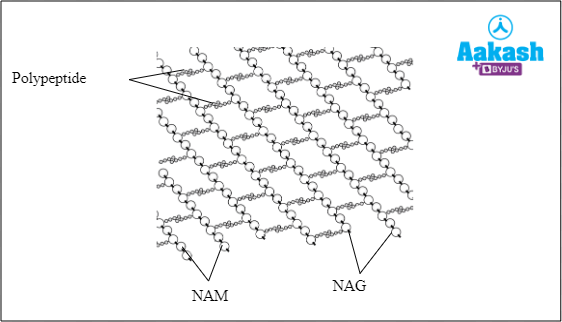
Fig: Peptidoglycan structure
The cell wall of prokaryotes such as archaebacteria, except for methanogenic arcahebacteria, is made up of polysaccharides and glycolipids in stead of peptidoglycan. Prokaryotic cells of Mycoplasma lack a cell wall.
Plasma membrane
The plasma membrane of most prokaryotic cells is composed of a phospholipid bilayer with proteins embedded in it. It is semipermeable in nature and resugates the entry and exit of substances in and out of the cell. Cell membrane of archaebacteria is composed of polysaccharides and glycolipids and is highly complex to allow them to thrive in their extreme habitats.
Cytoplasm
It is a colloidal complex which appears granular due to the presence of a large number of granular structures in it. The cytoplasm fills the whole cell. Streaming movement or cyclosis is not seen. A well-defined nucleus and membrane bound organelles are absent. The components of the cytoplasm are as follows:
Nucleoid
The nucleoid is the region in the cytoplasm where chromosomal DNA lies naked and free, in the absence of a well-defined nucleus. The prokaryotic genetic material consists of a single molecule of supercoiled circular DNA duplex which is stabilised by RNA and non-histone proteins.
Plasmid
Plasmids are extrachromosomal circular DNA lying in the cytoplasm which can self-replicate. Important genes such as antibiotic resistance genes, fertility factors, nif genes that help in nitrogen fixation, etc, are generally present on the plasmids.
Ribosomes
Ribosomes are non-membrane bound organelles which lie scattered in the cytoplasm and are involved with protein synthesis. The ribosome in bacterial cells is of the 70S type, made up of a smaller 30S subunit and a larger 50S subunit. ‘S’ refers to the Svedberg unit which is a measure of sedimentation coefficient.
During active protein synthesis many ribosomes attach themselves on an mRNA strand forming a polyribosome.

Fig: Subunits of prokaryotic ribosomes
Mesosomes
Invaginations of the plasma membrane form the mesosomes. Mesosomes contain important enzymes that participate in important metabolic processes such as respiration, DNA replication, cell wall synthesis, etc.
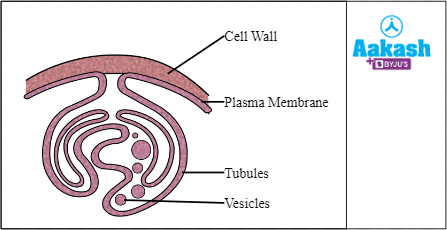
Fig: Mesosome
Chromatophores
These are cell membrane extensions which contain photosynthetic pigments such as bacteriochlorophyll. These are more common in cyanobacteria or blue green algae and are mainly involved with photosynthesis.
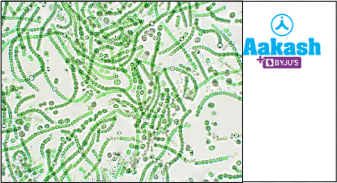
Fig: Nostoc containing chromatophore
Inclusion bodies
Inclusion bodies are reservoirs of inorganic and organic substances scattered in the cytoplasm. The inclusion bodies can be of the following types:
- Gas vacuoles which store gases to keep the cell buoyant
- Inorganic inclusions: magnetosomes (store iron compounds), volutin granules (store phosphate), sulphur granules (store sulphur compounds),
- Food reserves: Cyanophycean starch, lipid globules, protein granules
Flagella
The bacterial flagella is a locomotory organ composed of helically arranged subunits of globular flagellin protein. It is composed of a basal body, a hook and a filament. The basal body is embedded in the cell membrane while the hook and the filament are extended outside the cell surface. The filament is capable of rotating 360 degrees with the help of the basal body and the hook.

Fig: Structure of bacterial flagella
Pili
Numerous non-motile hair like processes cover the surface of some bacteria. These are known as pili and are made up of the pilin protein. They help in cellular attachment. During conjugation (a method of parasexual reproduction), specialised sex pili form a bridge between the male (donor) and the female (recipient) bacteria for the transfer of DNA.

Fig: Sex pilus in bacteria
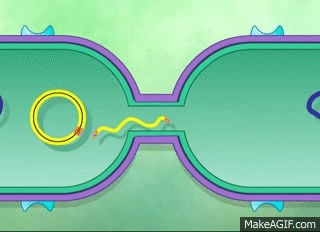
Fig: Conjugation in bacteria
Fimbrae
Small bristle-like protein fibres emerging out of the surface of some prokaryotic cells are known as fimbrae. They mainly help in the attachment of the bacteria to a solid surface, the host tissues and in mutual aggregation. Pathogenic bacteria such as Neisseria gonorrhoea attaches itself to the urinary tract of humans with the help of fimbrae.

Fig: Fimbriae in bacteria
General Structure of an eukaryotic cell
Eukaryotic cells are those which possess an organised nucleus and two envelop system of organisation, that is, a membranous envelope around the whole cell and membranous envelopes around cell organelles such as nucleus, endoplasmic reticulum, Golgi apparatus, lysosome, mitochondria and microbodies. Eukaryotic cells also posses naked or non-membrane bound organelles such as ribosomes, centrosomes and the cytoskeletal elements. Certain cell organelles such as the cilia and flagella extend out of the cell surface. The cell envelope is made up of cell wall and cell membrane in plant cells, fungal cells and some plant-like protists and it is made up of only cell membrane in animal cells and some other protists. The living matter of the cell, that is the protoplast is divided into a cytoplasm and a nucleus.
A system of membrane bound organelles work in close coordination with each other and collectively form the endomembrane system which includes the nuclear envelope, endoplasmic reticulum, Golgi apparatus, lysosomes and vacuoles.
Cell wall
It is the outermost, rigid covering of some eukaryotic cells that provides protection, shape, rigidity and support to the cells. It lies outside the cell membrane and is freely permeable to substances moving in and out of the cell. Plant cell wall is composed of cellulose, hemicellulose and pectin. Fungal cell wall is composed of chitin and cell walls of algae have cellulose, mannans, galactans, and minerals like calcium.

Fig: Plant cell wall
Cell membrane or plasma membrane
Plasma membrane is selectively permeable and made up of a bilayer of phospholipids with proteins arranged in a mosaic fashion. The proteins lying on the outer surface of the membrane may have glycoproteins and glycolipids attached to them. In cell wall possessing cells, the cell membrane is positioned internal to the cell wall but in other cells the cell membrane is the outermost covering. It regulates the entry and exit of substances across itself and thus helps to communicate with the external environment.

Fig: Structure of cell membrane
Cytoplasm
The jelly-like semisolid matrix enclosed by the cell membrane is the cytoplasm in which the cell organelles are scattered. The cytoplasm is composed of carbohydrates, amino acids, proteins, vitamins, enzymes, tRNAs, nucleotides, etc. The cytoplasm is a crystallo colloidal structure in which colloidal proteins exist with water as the dispersion medium. It exists in both biscous gel and a non-viscous sol form. The interchange between the two forms aid in the streaming movement of the cytoplasm, known as cyclosis.
All the biochemical reactions of the cell occur in the cytoplasm and cytoplasmic movements help in distribution of the metabolites in the cell. Functions such as internal movement of organelles, extension of pseudopodia, etc are aided by the cytoplasmic movements.

Fig: Cytoplasm
Nucleus
The nucleus is considered the brain of the cell as it regulates all the cellular activities. In eukaryotic cells it is well organised with a nuclear membrane that encloses the nucleoplasm and separates it from the cytoplasm. Tiny nuclear pores on the nuclear membrane allow movement of substances into and out of the nucleus. The nucleoplasm forms the ground matrix of the nucleus which is transparent and semifluid in nature. It holds a spherical nucleolus that is responsible for the synthesis of rRNA and assembly of ribosomal subunits. The nucleoplasm also houses the genetic material of the cell which is present in the form of chromatin fibres that are made up of long strands of DNA coiled around histone proteins, giving the fibres a beaded appearance.
The nucleus plays a major role in cell division and the correct distribution of chromosomes into daughter cells. Thus, it is also responsible for transfer of genetic material from one generation to the next.
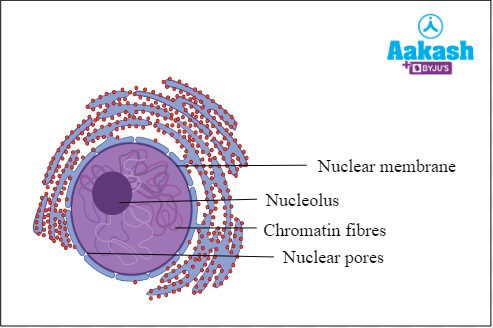
Fig: Nucleus
Endoplasmic reticulum
The endoplasmic reticulum can be seen as network of tubules and vesicles bound by a single membrane spanning across from the nuclear membrane on one end to the cell membrane on the other. All eukaryotic cells except mature RBCs have an endoplasmic reticulum. It can be of two types -
- Rough endoplasmic reticulum with ribosomes attached to the outer surface
- Smooth endoplasmic reticulum that are free of ribosomes.

Fig: Types of endoplasmic reticulum
The ER helps in the intracellular transport of material. RER acts as a site for protein synthesis whereas SER acts as a surface for the synthesis of lipids and steroids. It provides skeletal framework to the cell.
Golgi apparatus
The Golgi body or Golgi apparatus consists of cisternae which are flattened sac-like strcutures, tubules and vesicles. Parallelly stacked cisternae are arranged in a concentric manner close to the nucleus. The vesicles help in packaging and transporting molecules and are formed by pinching off from the tubules. The Golgi complexes in plant cells are smaller and known as ‘dictyosomes’.

Fig: Parts of a Golgi apparatus
The Golgi bodies are responsible for packing and transporting proteins, synthesising glycoproteins and glycolipids and help in secretion of enzymes, hormones, etc.
Mitochondria
All eukaryotic cells carrying out aerobic respiration have the mitochondria which is the powerhouse of the cell. It is bound by a double membrane and its inner membrane folds to form finger-like projections called ‘cristae’. An intermembrane space or the perichondrial space exists between the outer and inner mitochondrial membranes and a mitochondrial matrix lies inside the inner membrane.
Mitochondria acts as the site for Krebs cycle and the electron transport chain during aerobic respiration and helps in the complete breakdown of glucose to generate chemical energy in the form of ATP. Mitochondria is considered to be a semi autonomous cell organelle as it has its own RNA, DNA and 70S ribosomes.

Fig: Internal structure of mitochondria
Lysosomes
These are single membrane bound organelles that contain hydrolytic enzymes. These help in protecting the cell by engulfing foreign bodies that invade the cell. They are responsible for intracellular digestion and are also known as suicidal bags of the cell as they can digest the organelles of the host cell when the cell is starved, injured or old. Lysosomes are rarely found in plant cells.

Fig: Intracellular digestion by lysosomes
Vacuoles
Vacuoles are storage organelles which are bound by a single membrane and are filled with a fluid substance known as the cell sap. The membrane surrounding the fluid is known as the tonoplast. Plant cells have a centrally places single large vacuole whereas animal cells either have few very small vacuoles or no vacuoles at all. Vacuoles help in regulating the osmotic balance of the cell, help to maintain turgidity and store water and solutes for the cell.

Fig: Vacuole within a plant cell
Plastids
Plastids are found only in plant cells and are organelles bound by a double membrane. These organelles are divided into three types based on what pigment they contain - chloroplast, chromoplast and leucoplast.
Chloroplasts are green coloured plastids that contain the chlorophyll pigment. They are primarily involved in photosynthesis as the green chlorophyll pigment can absorb light waves in the red and blue spectrum and can thus trap light energy. This energy is utilised for synthesisng carbohydrates (glucose) and water from CO2 and water. Photosynthetic plants and algae show the presence of chloroplasts in their cells.
Internally, the chloroplast comprises a colourless ground substance named stroma in which stacks of flattened sacs or thylakoids are arranged. Each stack is known as a granum and are collectively called grana. Chloroplast is considered to be a semi autonomous cell organelle as it has its own RNA, DNA and 70S ribosomes.
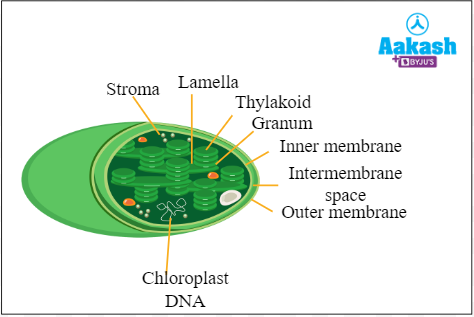
Fig: Chloroplast
Chromoplasts are red, orange and yellow coloured plastids which impart colour to the fruits and flowers of the plant. They contain carotenoid and xanthophyll pigments.
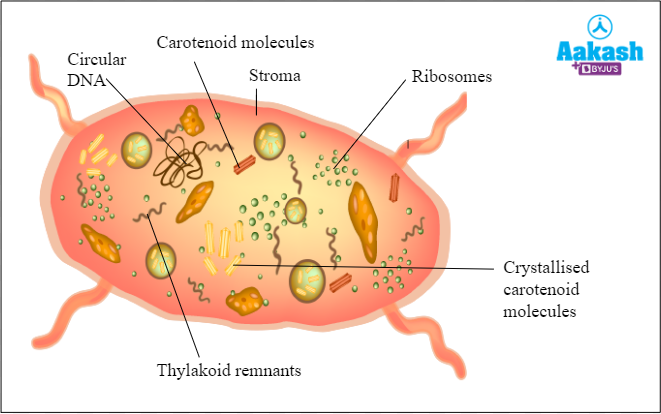
Fig: Chromoplast
Leucoplasts do not contain any piments and are mainly involved with storage of starch (amyloplasts), proteins (aleuroplasts) or fats (elaioplasts).

Fig: Leucoplasts
Microbodies
Microbodies or cytosomes are vesicular organelles bound by a single membrane which enclose various enzymes. These include glyoxysomes , spherosomes and peroxisomes. Sphaerosomes are specifically present in plant cells but peroxisomes and glyoxysomes are seen in both plant and animal cells. The microbodies mainly contain oxidative enzymes and help in breaking down peroxides and oxidative metabolic reactions. Peroxisomes mainly help in the breakdown of long chain fatty acids in animal cells, photorespiration in plant cells, etc. Glyoxysomes help in the synthesis of carbohydrates from stored fats using the glyoxylate cycle. Sphaerosomes are primarily involved with synthesis of lipids and their storage.

Fig: Structure of peroxisomes
Ribosome
Eukaryotic ribosomes are of the 80S type, made up of a smaller 40S and larger 60S subunit. As we know ribosomes are not bound by a membrane and are composed of rRNA and proteins. Ribosome synthesis occurs in the nucleolus and they are either scattered in the cytoplasm or attached to the outer surface of the rough endoplasmic reticulum. Their primary function is synthesis of proteins.
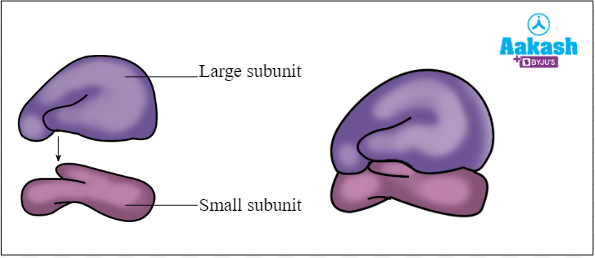
Fig: Structure of ribosome
Cytoskeletal structures
A network of microfilaments, microtubules and intermediate filaments comprise the cytoskeleton of the cell. The components of the cytoskeleton can disassemble and reform based on the needs of the cell so it’s not a fixed structure. The cilia, flagella and centrosome of a cell are composed of elements of the cytoskeletal elements.

Fig: Cytoskeletal elements
Centrosome
Centrosome is a non-membrane bound organelle composed of two centrioles that are perpendicular to each other and connected by interconnecting fibres. Plant cells have centrioles but they are not organised into centrosomes whereas centrosomes are present in animal cells. The centrosome helps in cell division because spindle fibres are formed by the centrioles. In the animal cells, centrioles also help in the formation of the basal bodies of cilia and flagella.

Fig: Centrosome
Cilia and flagella
Cilia and flagella are fine vibratile hair-like membrane outgrowths that extend outside the free surface of the cells and take part in producing a current in fluid medium for the passage of materials and locomotion. Cilia are short and numerous and help in passage of materials by beating in a coordinated fashion.
Flagella are longer and fewer in number and help in locomotion with their whiplash movements.
Cilia and flagella are made up of four major parts - basal body, rootlets, basal plate and the shaft. The basal body of these structures is made up of microtubules arranged in the 9+0 pattern, that is nine peripheral microtubules and no microtubules in the centre, whereas in the shaft the pattern of microtubule arrangement is 9+2, that is, nine peripheral microtubules and two central microtubules.
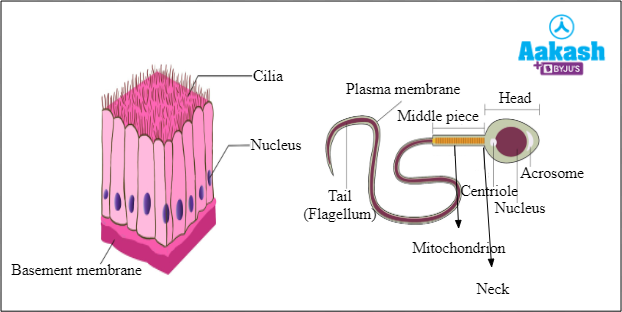
Fig: Examples of cilia and flagella in animals
Functions of the cell:
The cell is not only the structural but also the functional unit of the cell. All the metabolic reactions in an organism’s body occur within the cell. In unicellular organisms all the functions such as nutrition, respiration, excretion, reproduction are carried out by the cells. In multicellular organisms, all the life processes carried out by the organism are a sum total of the functions carried out by the cells it is composed of. The cells perform a variety of functions such as -
- All anabolic reactions such as protein synthesis, lipid synthesis, photosynthesis in plants, etc and catabolic reactions such as breakdown of carbohydrates during respiration occur within the cell.
- In multicellular organisms, cells provide shape and structure to the organisms.
- Cells help in energy production in the organism by carrying out respiration.
- Mitotic cell division helps multicellular organisms to grow.
- Cells help in secretion of hormones, signalling molecules, etc to communicate with each other and coordinate functions in the body.
- Meiotic cell division helps in gamete production for sexual reproduction in organisms.
- Specialised cells in the alimentary canal of animals help in secretion of enzymes for digestion and absorption of nutrients.
- Specialised cells such as nerve cells in animals can conduct impulses for connecting different body parts.
- Cells in the lining of internal organs in animals help in diffusion of substances, provide protections, etc.
- In plants, meristematic cells divide and help in growth, the cells such as parenchyma, collenchyma, sclerenchyma help in providing strength and support and the cells of the vascular bundles help in conduction of substances in the plant body.
Practice Problems
1. Match the following:
|
Cell organelle |
Function |
|
1. Aerobic respiration |
|
2. Stores starch |
|
3. Conversion of fats to carbohydrates |
|
4. Formation of spindle fibres |
- A - 2, B - 3, C - 4, D - 1
- A - 3, B - 1, C - 4, D - 2
- A - 4, B - 2, C - 3, D - 1
- A - 1, B - 4, C- 2, D - 3
Solution: The amyloplasts are a type of leucoplast that help to store starch in plant cells. Glyoxysomes help in the synthesis of carbohydrates from stored fats using the glyoxylate cycle. Centrioles help in formation of spindle fibres during cell division and the mitochondria is the site for Krebs cycle and the electron transport chain during aerobic respiration in eukaryotic cells.
Thus, the correct option is a.
2. Assertion (A): Chloroplast has its own genetic materials.
Reason (R): Chloroplast is known as the semi-autonomous cell organelle.
- Both, A and R, are true and R is the correct explanation of A
- Both, A and R, are true but R is not the correct explanation of A
- A is true but R is false
- Both A and R are false
Answer: The chloroplast is a green plastid found in plant cells that contains the chlorophyll pigment and helps to trap light energy for photosynthesis. It is considered to be a self autonomous organelle as it has its own genetic material in the form of DNA which enables it to regulate its own division. It can also synthesise its own proteins due to the presence of 70S ribosomes.
Hence the correct option is a.
3. Which of the following organelles is found only in plant cells?
- Golgi apparatus
- Mitochondria
- Sphaerosomes
- Ribosomes
Answer: Sphaerosomes are specifically present in plant cells. Sphaerosomes are primarily involved with synthesis of lipids and their storage. Golgi apparatus, mitochondria and ribosomes are present in both plant and animal cells. Thus the correct option is c.
4. Which of the following contains photosynthetic pigments in cyanobacteria?
- Chloroplast
- Chromoplast
- Chromatophore
- Chromosome
Solution: Chromatophores are cell membrane extensions found in cyanobacteria which contain photosynthetic pigments such as bacteriochlorophyll.
Thus, the correct option is c.
FAQs
- When was the distinction between a prokaryotic cell and an eukaryotic cell first established?
Answer: Although Édouard Chatton (1937) was the first person to recognise the distinction between prokaryotic and eukaryotic cells in his book Titres et Travaux Scientifiques, the distinction was firmly established by C. B. van Niel and Roger Stanier in their paper The concept of a bacterium that was published in 1962.
- Where are ribosomes formed in prokaryotic cells?
Answer: Ribosome biogenesis in eukaryotes occurs within the nucleolus but in prokaryotes it occurs in the cytoplasm when many operons containing the genes coding for ribosomal proteins and rRNAs are transcribed.
- How many cells are present in the human body?
Answer: With the help of detailed study of the volume and density of cells in various tissues, scientists have estimated that an average human body is composed of 37.2 trillion cells!
- What limits cell size?
Answer: The upper limit of cell size or cell volume is determined by multiple factors:
- Metabolic activity - metabolically active cells are smaller in size than metabolically inactive ones.
- Nucleocytoplasmic ratio - As the nucleus controls all the metabolic activities of the cell, a small size results in higher nucleocytoplasmic ratio which helps in more efficient regulation.
- Inflow of materials - Intracellular transport of nutrients and gases that are taken up by the cell is easier with a smaller size.
- Removal of wastes - The cell should be small in size so that wastes can be eliminated as soon as they are formed.
- Surface area to volume ratio - Smaller the cell, higher is the ratio which helps in efficient diffusion of substances in and out of the cell and also helps in more efficient communication between cell organelles.
YOUTUBE LINK: https://youtu.be/-NOY_k8iN9A



